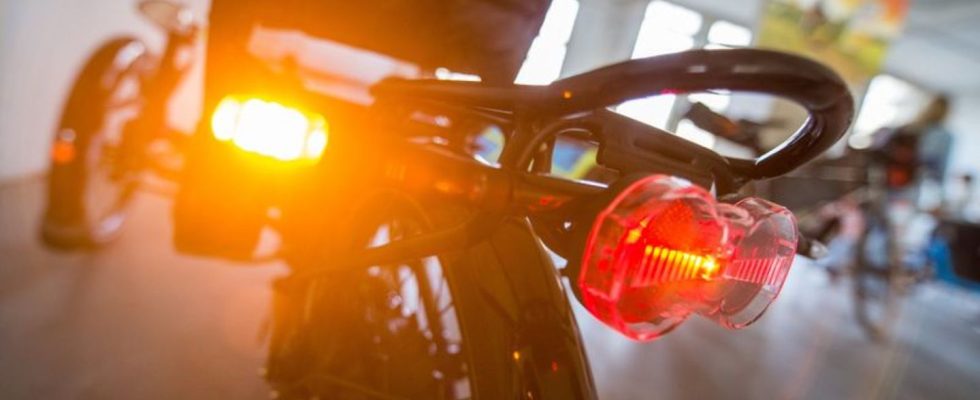Road traffic
Federal government wants to allow indicators for all bicycles
A bicycle indicator on a recumbent bike. The federal government now wants to allow indicators for all bicycles when turning. photo
© Arne Bänsch/dpa
Many cyclists use a hand signal when turning. Indicators would be easier to see, especially in the dark. This should now be possible – but there should be no obligation.
The federal government wants indicators for everyone Allow bicycles when turning. The background is also the increasing number of accidents with Pedelecs. The new regulation is planned as part of a new version of the road traffic registration regulations, said a spokeswoman for the Federal Ministry of Transport on Thursday in Berlin. The plans also emerge from the federal government’s response to a parliamentary question, which was first reported by the “Rheinische Post”.
What is planned
According to the current road traffic registration regulations, “direction indicators” are only permitted on multi-lane bicycles and bicycles with a body such as cycle rickshaws, where the driver’s hand signals are completely or partially hidden.
The spokeswoman said the Ministry of Transport was concerned about the increasing number of accidents involving pedelecs – the number of bicycles with auxiliary motors has increased significantly in recent years. In order to indicate the turn, it is currently necessary to take your hand off the handlebars. In difficult situations, this could lead to driving stability being impaired and braking behavior changed. This could be defused by optionally permitted direction indicators. Optional turn signals could replace the hand signal when cyclists indicate that they want to turn.
It is currently unclear when indicators will be permitted on all bicycles. Due to the complexity of the extensive draft of the new version of the Road Traffic Licensing Regulations, according to the ministry, it is not yet possible to predict when the responsible Federal Council will deal with it and when the new regulations will come into force.
Cycling club for indicators
According to its legal expert Roland Huhn, the General German Bicycle Club (ADFC) has long been campaigning for indicators to be permitted on all bicycles and Pedelecs – as voluntary equipment, not as a requirement. “Direction indicators are easier to see than hand signals, especially in the dark, and remain effective during the entire turning process during the day, which often requires both hands to apply the brakes.”
In this way, turning cyclists are easier to notice, says Huhn. Particularly when turning left, there are often serious collisions with following or oncoming vehicles because cyclists are overlooked. “You can expect that consciously chosen bicycle indicators will be used consistently – more often than the hand signal that is often omitted. Of course, indicators on bicycles are no substitute for other traffic safety measures or for looking around before turning.”
More traffic safety?
The FDP transport politician Valentin Abel said: “The focus must be on the safety of all road users in order to reduce the risk of accidents, especially in dangerous places, and thereby protect lives. From the FDP parliamentary group’s point of view, the introduction of optional bicycle indicators can make a contribution to reducing Conflicts with motorized traffic.”
The German Road Safety Council welcomed the plans. President Manfred Wirsch said that indicators could contribute to greater road safety and fewer injuries in road traffic. “Turning becomes safer because both hands remain on the handlebars, and the intention to turn is more visible to other road users, especially at night. Collisions with cyclists turning left often have serious consequences Injuries result and could be reduced in this way.”
A spokeswoman for the ADAC said that from the ADAC’s point of view the step was right and important for road safety. The current regulation is incomprehensible and no longer seems up-to-date. “Elderly people with physical limitations in particular find access to the bike easier with the electric assistance. They often find it difficult to give hand signals because one hand has to be taken off the handlebars.”
Siegfried Brockmann, head of accident research for the insurer, said that a turn signal obviously has advantages in the dark, especially if you want to turn and have to stop in the middle to wait for oncoming traffic. “On the other hand, there can also be additional dangers if I forget to turn off the indicator during the day. Overall, either way, this is definitely not a milestone in improving cycling safety.”
The transport policy spokesman for the Green parliamentary group, Stefan Gelbhaar, was also skeptical. “Indicators on normal road bikes will not increase traffic safety,” he told the Düsseldorf “Rheinische Post”. Even if the previous bans are not necessary, normal road bikes are too narrow for indicators, so that the direction indicator can hardly be noticed. Instead, good cycling infrastructure and appropriate speeds make more sense for greater safety. “Especially in urban areas, a speed limit of 30 helps to significantly reduce the risk of accidents and damage caused by accidents.”

